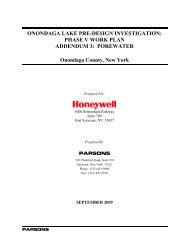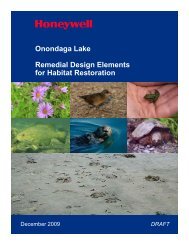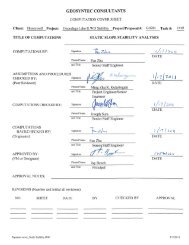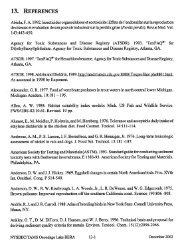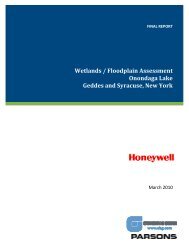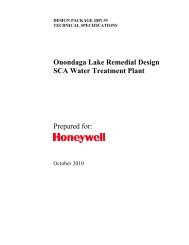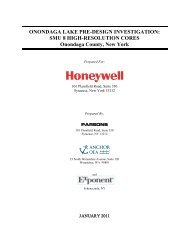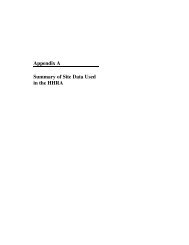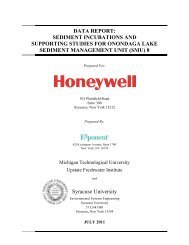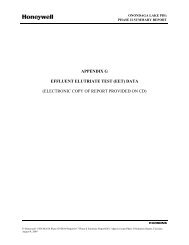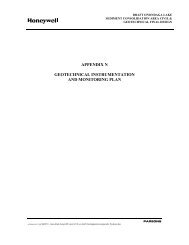Phase 1B Underwater Archaeological Report for the Onondaga ...
Phase 1B Underwater Archaeological Report for the Onondaga ...
Phase 1B Underwater Archaeological Report for the Onondaga ...
You also want an ePaper? Increase the reach of your titles
YUMPU automatically turns print PDFs into web optimized ePapers that Google loves.
FINAL<br />
<strong>Phase</strong> IB <strong>Underwater</strong> <strong>Archaeological</strong> Resources <strong>Report</strong> <strong>for</strong> <strong>Onondaga</strong> Lake Superfund Site<br />
Plank-on-Frame A shipbuilding technique, also commonly known as carvel built. Vessels of this type<br />
have planking running <strong>for</strong>e and aft with <strong>the</strong> planking laid edge to edge.<br />
Port The left side of a vessel when facing <strong>for</strong>ward.<br />
Primary Source An artifact, document, or individual that provides in<strong>for</strong>mation based on personal<br />
observations. A firsthand account.<br />
Provenience The original location of an object, in reference to artifacts it is <strong>the</strong> exact location in which<br />
<strong>the</strong>y were found.<br />
Rabbet a concavity in <strong>the</strong> keel or chine log into which <strong>the</strong> planking is fit.<br />
Rake The projection of a ship, at stem or stern, beyond <strong>the</strong> ends of <strong>the</strong> keel.<br />
Rake timber Timber that acts as framing <strong>the</strong> raked end of a scow.<br />
Rider Interior frame mounted inside a ship’s hold and bolted to o<strong>the</strong>r structural elements to streng<strong>the</strong>n<br />
<strong>the</strong> ship’s structure.<br />
Rigging The hardware and equipment that support and control <strong>the</strong> spars and sails of a vessel.<br />
Rigging block A wooden pulley used to operate a vessel’s spars and sails.<br />
Room and Space The distance between <strong>the</strong> moulding edges of two adjoining frames.<br />
Rub Plate A metal band placed on <strong>the</strong> <strong>for</strong>ward end of <strong>the</strong> stem and bottom of <strong>the</strong> keelson to protect<br />
<strong>the</strong> underlying wood.<br />
Rubwale See Rub Strake<br />
Rub Strake: A rail on <strong>the</strong> outside of <strong>the</strong> hull of a boat to protect <strong>the</strong> hull from rubbing against piles,<br />
docks and o<strong>the</strong>r objects<br />
Rudderpost A vertical timber in <strong>the</strong> stern of <strong>the</strong> vessel to which <strong>the</strong> rudder is attached<br />
Scarf An overlapping joint to connect two timbers or planks without increasing <strong>the</strong>ir dimensions.<br />
Schooner A <strong>for</strong>e-and-aft-rigged sailing vessel with two or more masts.<br />
Scow Flat bottomed watercraft, normally rectangular in cross-section with outward sloping ends.<br />
Secondary source An individual's description and interpretation of a historical event recorded at a<br />
different time and place. A secondhand account.<br />
Sheer strake The top strake, or plank, of a wooden vessel next below <strong>the</strong> gunwale.<br />
Sided dimension The measurement of width of a timber as seen in a plan view of a vessel.<br />
Sloop A single-masted, <strong>for</strong>e-and-aft-rigged sail boat.<br />
Spar A pole used to help support <strong>the</strong> sail of a vessel.<br />
Spike A large nail.<br />
Spud: Posts found on some barges which are lowered from <strong>the</strong> barge and pushed into <strong>the</strong> waterway<br />
floor to anchor <strong>the</strong> vessel in place.<br />
Stanchion An upright supporting post.<br />
Standing Knee A vertical L-shaped timber attached to <strong>the</strong> top of a deck beam, or decking; used to<br />
connect and rein<strong>for</strong>ce <strong>the</strong> junction of a deck beam with <strong>the</strong> side of <strong>the</strong> vessel.<br />
234



